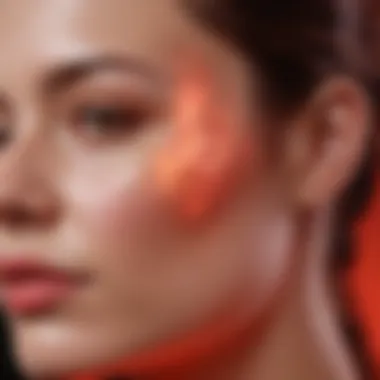Understanding Red Light Therapy for Facial Treatments


Intro
Red light therapy (RLT) is gaining traction as a non-invasive treatment for various skin concerns. This therapy employs specific wavelengths of light, typically in the red and near-infrared spectrum, to stimulate cellular processes. Understanding the fundamental principles underpinning RLT is crucial to appreciate its application in facial treatments.
The skin is highly impacted by various environmental factors, such as UV radiation, pollution, and aging. Thus, there is a continuous quest for effective treatments that can enhance skin health and appearance. RLT has emerged as a promising option, but it is essential to critically analyze the scientific support and potential limitations of this therapy.
A more thorough investigation into how red light affects skin at the cellular level will be outlined, including insights into its benefits and considerations for safe use. By examining current research, this article aims to equip readers with valuable knowledge, whether for personal use or professional practice.
Preface to Red Light Therapy
The topic of red light therapy is gaining increasing attention for its potential in facial treatments. As people seek effective and non-invasive ways to improve their skin health, understanding how this treatment works and its benefits becomes essential. Red light therapy involves using specific wavelengths of light to target various skin conditions, leading to rejuvenation and enhancement of overall appearance. Many individuals are drawn to this therapy due to its promise of results without the need for invasive procedures.
A significant advantage of red light therapy is its ability to stimulate cellular activity. This stimulation can boost collagen production and promote healing, making it a popular choice for those aiming for youthful and glowing skin. The non-invasive nature of the therapy allows it to fit seamlessly into beauty regimens, appealing to a wide audience from skincare enthusiasts to those concerned with aging.
Defining Red Light Therapy
Red light therapy, also known as low-level laser therapy, employs light in a specific spectrum—usually between 600 to 650 nanometers. This non-thermal light penetrates the skin and influences cellular processes. The method is relatively simple: a device emits red light, which is absorbed by the skin. This absorption triggers a number of biochemical processes, providing beneficial effects on skin health.
History and Development
The origins of red light therapy are found in the experiments of scientists as early as the 1960s. It was initially developed to help with wound healing and tissue repair. Over time, researchers discovered additional applications, specifically in the fields of dermatology and aesthetics. Established scientific studies began to emerge in the late 20th century, gradually revealing its potential benefits for skin rejuvenation.
As technology progressed, devices became more accessible, making red light therapy a more popular option in both professional and home settings. Various forms of equipment have since been developed, including portable devices, sleek panels, and professional-grade light sources. This evolution highlights the growing recognition of the therapy's efficacy and the demand for effective skincare solutions.
Mechanisms of Action
Understanding the mechanisms of action behind red light therapy is essential. This knowledge helps reveal how it works on a cellular level, which is crucial for appreciating its benefits for facial treatments. The way red light interacts with skin cells can explain many of the observed effects, from stimulating collagen production to aiding in tissue repair.
How Red Light Affects Cells
Red light therapy operates primarily by influencing biological processes on a cellular level. When red light penetrates the skin, it reaches various layers and interacts with the cells within those layers. One significant effect is the stimulation of mitochondria, the energy-producing components in cells. The exposure to red light enhances mitochondrial function, leading to increased ATP production. ATP, or adenosine triphosphate, is the molecule that stores and transports energy within cells.
By boosting ATP, red light promotes cellular metabolism and regeneration. This increase in energy availability can lead to faster healing and rejuvenation of the skin. Additionally, red light may enhance blood circulation, leading to better oxygenation and nutrient delivery to skin cells. This enhanced nutrient supply is crucial for skin repair and overall health.
Wavelengths and Their Impact
Different wavelengths of red light have distinct impacts on skin cells. For facial treatments, wavelengths typically range from 600 to 650 nanometers. This range is particularly effective for penetrating the skin without causing damage. The absorbed light triggers various biochemical reactions.
- Shorter wavelengths within this spectrum tend to stimulate more surface-level processes. They can help with skin surface issues, like fine lines and overall texture.
- Longer wavelengths, on the other hand, penetrate deeper and may assist in targeting underlying structures, which is beneficial for promoting collagen synthesis and reducing inflammation.
Ultimately, understanding these wavelengths allows practitioners to choose the most appropriate red light settings for specific skin issues and treatment goals. This precision helps optimize the efficacy of the therapy, ensuring patients receive the best possible results.
"The effectiveness of red light therapy is largely determined by both the wavelength used and the duration of the exposure."
Benefits of Red Light Therapy for the Face
Red light therapy is not simply a trend in skincare; it presents a multitude of significant benefits for facial treatments. As individuals seek alternatives or complements to conventional dermatological methods, understanding the inherent advantages of red light therapy becomes imperative. This modality shines in areas such as enhancing skin rejuvenation, reducing inflammation, and boosting collagen production. Each of these benefits contributes to overall skin health and vitality.
Skin Rejuvenation
Skin rejuvenation is one of the most widely discussed benefits of red light therapy. The therapy promotes cellular regeneration and healing. When red light penetrates the skin, it stimulates the mitochondria within cells. These cellular powerhouses increase adenosine triphosphate (ATP) production, which is essential for cellular function and repair.


As a result, individuals often experience improvements in skin texture and tone. Studies show that red light therapy can help reduce the appearance of fine lines and wrinkles. This is particularly valuable for those who are aging or have skin damaged by sun exposure. Moreover, consistent treatments can result in increased hydration and a more youthful glow, making it a desirable option for many.
Reducing Inflammation
Reducing inflammation is another crucial benefit of red light therapy. Skin conditions such as acne, rosacea, and eczema often stem from inflammatory responses. Red light therapy assists in modulating these responses. This is achieved by enhancing blood circulation and consequently promoting better nutrient delivery to skin tissues.
Research has indicated that red light can lower the levels of pro-inflammatory cytokines. This action leads to a reduction in redness and swelling. For individuals who struggle with chronic inflammation, integrating red light therapy into their skincare regimens could lead to substantial improvements in skin appearance and health.
Boosting Collagen Production
Another significant advantage is the boost in collagen production. Collagen is a fundamental protein that provides structure and elasticity to the skin. As people age, natural collagen production declines, resulting in sagging skin and the formation of wrinkles. Red light therapy has been shown to stimulate fibroblasts, the cells responsible for collagen synthesis.
Increased collagen levels can improve skin firmness and elasticity. This is particularly beneficial for individuals looking to address signs of aging or restore volume to their faces. Consistent use of red light therapy can lead to visibly plumper, smoother skin. Ultimately, the increase in collagen can transform an individual’s complexion, making it an essential part of an effective skincare strategy.
In summary, the benefits of red light therapy for the face are multifaceted, impacting rejuvenation, inflammation reduction, and collagen enhancement. This therapy provides a holistic approach to skincare, promoting healthier skin at a cellular level.
Scientific Perspectives
Scientific perspectives on red light therapy are crucial in understanding its applicability and effectiveness for facial treatments. This section discusses the clinical studies that support red light therapy, providing evidence for its role in improving skin health. Additionally, it examines the limitations inherent in current research. Recognizing both the strengths and weaknesses of the scientific literature is essential for making informed choices regarding this therapy.
Review of Clinical Studies
Several clinical studies have investigated the impact of red light therapy on facial skin health. These studies generally focus on the therapy’s capacity to promote collagen synthesis, mitigate wrinkles, and enhance overall skin appearance. One prominent study published in the Journal of Cosmetic Dermatology demonstrated a significant increase in collagen density after just a few sessions of red light exposure.
Moreover, other trials have highlighted the therapy's ability to reduce inflammation and improve skin clarity. A systematic review in Dermatologic Surgery analyzed multiple trials reporting positive outcomes, such as reduced acne lesions and improved skin texture.
The consistency of positive results across various studies indicates a promising trend. However, the heterogeneity in study design, treatment parameters, and patient populations poses challenges in drawing definitive conclusions. Factors like wavelength, intensity, and frequency of treatment vary widely, influencing the results.
"The scientific community recognizes the potential of red light therapy, yet emphasizing the need for rigorous standards in research to validate its effectiveness."
Limitations of Current Research
Despite the encouraging findings, certain limitations affect the interpretation of current research on red light therapy. One primary concern is the lack of standardized protocols across studies. Without uniform treatment parameters, it becomes difficult to compare results or establish recommended practices. For example, variations in light wavelengths, power densities, and treatment durations may lead to differing outcomes.
Furthermore, many studies suffer from small sample sizes or short follow-up periods, limiting their long-term applicability. Some clinical trials do not adequately account for placebo effects, leading to inflated efficacy perceptions.
The research on red light therapy is still evolving. More extensive studies with well-defined protocols are essential for clarifying its full potential and limitations. Robust data can facilitate a deeper comprehension of how red light therapy can be optimally harnessed in dermatological practices, ultimately guiding more effective treatment options for patients.
Practical Considerations
When exploring the realm of red light therapy for facial treatments, understanding practical considerations becomes essential. These considerations encompass aspects that influence the overall effectiveness of the therapy and the experience of the individual receiving treatments. Proper protocols, suitable equipment, and safety measures contribute significantly to the efficacy of the therapy. Not only do these aspects enhance treatment outcomes, but they also ensure the best possible user experience, which is critical for those engaging in skincare routines aimed at optimizing health and well-being.
Treatment Protocols
Establishing effective treatment protocols is one of the cornerstones of successful red light therapy. Treatment protocols often vary based on skin type, conditions being addressed, and the specific device used. Generally, a session can last from 10 to 30 minutes, and frequency of sessions can range from two to five times a week.
Some essential elements to consider when formulating treatment protocols include:
- Skin Condition: Tailor the regimen based on concerns, be it acne, wrinkles, or pigmentation issues.
- Device Type: Different devices may have varying intensity levels, affecting the duration and frequency of treatments.
- User Sensitivity: Individual skin responses to red light can vary, so it is vital to start with shorter sessions and gradually increase duration.
It is advisable to consult professionals or follow manufacturer recommendations, ensuring treatments align with personal skin goals while maximizing benefits.


Equipment and Devices
The selection of appropriate equipment is pivotal in ensuring effective red light therapy. There is a myriad of devices available, each designed for specific uses and outcomes. These can range from handheld units to led masks or panels.
Key factors to consider include:
- Wavelength: Devices should ideally emit light within the 600-650 nm spectrum for optimal efficacy.
- Power Output: The intensity of the light affects treatment duration and overall results, so it's crucial to choose a device with adequate power.
- Ease of Use: Some devices are more user-friendly, facilitating consistent home use. This factor is important for individuals aiming for long-term results.
Understanding the nuances of different equipment choices can help individuals choose devices that not only meet their specific needs but also fit into their lifestyle.
Safety Considerations
While red light therapy is generally considered safe, it is essential to address safety considerations. The therapy is non-invasive, but users should be aware of potential risks and contraindications.
- Skin Sensitivity: People with light-sensitive skin may experience redness or irritation. Test small areas first to gauge reactions.
- Pre-existing Conditions: Individuals with certain medical conditions, such as lupus or skin cancer, may need to avoid this therapy. Consulting with a healthcare provider is advisable.
- Protective Measures: Adequate eye protection should be worn during treatments to minimize potential light damage.
It's crucial to approach red light therapy with awareness and caution, ensuring that individual safety is prioritized.
By paying attention to these practical aspects, individuals can make informed decisions that enhance their red light therapy experience and outcomes.
Integrating Red Light Therapy into Beauty Regimens
Integrating red light therapy into beauty regimens represents a significant stride toward more holistic approaches to skincare. The growing interest in holistic beauty reflects a shift in consumer preferences, where people seek treatments that are effective yet gentle on the skin. Red light therapy offers numerous benefits that align with these preferences, making it a compelling option for individuals focused on enhancing their skin health.
Regular incorporation of red light therapy can help mitigate various skin issues such as aging, dullness, and inflammation. By using red light as a part of a daily or weekly beauty routine, individuals can experience cumulative benefits. This method integrates well with existing practices, such as topical applications. Pairing light therapy with serums or other treatments can optimize the absorption of active ingredients, enhancing their effectiveness.
Moreover, it is essential to note that red light therapy can complement a range of aesthetic procedures. For instance, individuals who undergo chemical peels or microdermabrasion can significantly benefit from red light sessions post-treatment, as it may aid in reducing redness and promoting faster recovery.
Combining with Other Treatments
When considering beauty regimens, the synergy created by combining red light therapy with other treatments cannot be overlooked. Popular treatments, such as microneedling and chemical peels, can be complemented by red light therapy to promote healing and enhance results. This combination not only helps to improve collagen production, enabling skin to look firmer and more youthful but also serves to soothe skin after invasive procedures.
- Red light can follow up after microneedling sessions to help reduce inflammation.
- In the case of facials, using red light afterward may extend the benefits of the facial products applied.
The integration of red light therapy into varied treatment plans may vary based on individual skin types and conditions. It can offer a versatile option for those wanting to enhance their skin’s appearance while taking care to ensure skin health.
Frequency and Duration of Use
Establishing the correct frequency and duration for red light therapy sessions is crucial for achieving optimal results. Recommended practices often suggest using red light therapy about two to three times a week for effective outcomes. Each session can last anywhere from 10 to 20 minutes, depending on the device used and skin sensitivity.
Regular use over time builds cumulative benefits, which means that consistency is more important than intensity. Practitioners must also consider their skin’s response. For instance, individuals new to red light therapy might start with shorter sessions or less frequent applications to avoid irritation.
In summary, integrating red light therapy into established beauty routines can elevate skincare practices through its synergistic effects with other treatments while requiring careful attention to usage frequency and duration to ensure safety and effectiveness. This method not only aids in improving skin quality but encourages a thorough understanding of individual skincare needs.
Limitations and Contraindications
In the realm of facial treatments, understanding the limitations and contraindications of red light therapy is crucial. While the technology promises various benefits, not every individual is suitable for every treatment. Identifying these factors helps ensure safety and maximizes effectiveness.
Potential Side Effects
Red light therapy is generally considered safe, but it can lead to several side effects in certain individuals. Common side effects may include:


- Temporary redness: This can occur on the treated areas and usually resolves quickly.
- Skin irritation: Some users might experience irritation; this often results from sensitivity to light.
- Discomfort: A feeling of warmth or slight tingling may happen during sessions.
In rare cases, more severe side effects could occur. If you experience unusual pain, rashes, or persistent irritation, consult a healthcare professional immediately. It is essential to observe your skin's reaction during and after therapy to evaluate tolerability.
Who Should Avoid Red Light Therapy
While many people can benefit from red light therapy, certain groups should exercise caution or completely avoid it. These include:
- Individuals with light sensitivity: Those who have conditions like lupus or are undergoing treatments that increase sensitivity to light may experience adverse reactions.
- Pregnant or nursing women: Although specific studies aren't extensive, it is prudent for this group to consult medical advice before proceeding with any new treatment modality.
- People with certain skin conditions: Common skin issues, such as eczema or psoriasis, can worsen with light exposure. Consulting a dermatologist before beginning treatment is advisable.
Future Directions
Future directions in red light therapy for facial treatments signify a critical juncture in the ongoing development and application of this technology. As interest grows among potential users and practitioners, it becomes essential to consider what innovations and research are needed to maximize efficacy.
Continued exploration of red light therapy's applications can lead to safer, more effective devices and treatment protocols. The landscape is shifting rapidly due to advances in technology and a better understanding of skin biology, providing exciting possibilities for wider usage. The integration of artificial intelligence and machine learning into treatment protocols could enhance personalized therapies, adapting wavelengths, intensities, and durations to individual skin responses.
Additionally, exploring combinations of red light therapy with other modalities such as microdermabrasion or chemical peels could yield synergistic effects, improving overall skin health. These multidimensional approaches may produce deeper penetration of nutrients and healing properties through enhanced micro-circulation.
"The future of red light therapy holds significant promise for revolutionizing skin treatments through innovative technologies and research collaboration."
Emerging Technologies
Emerging technologies in red light therapy include advanced devices that provide more targeted treatments. For instance, LED panels are evolving with greater energy efficiency and user-friendly designs. More recent advancements are in handheld LED devices that allow focused treatment on smaller areas of the face, simplifying at-home usage. These devices can also couple red light with other wavelengths, broadening their therapeutic scope.
Moreover, integrating red light therapy with wearable technology presents a novel approach. Devices can be designed to monitor skin condition and adjust treatment parameters in real-time. Such integration could lead to more responsive skin care strategies, ensuring optimal results based on specific needs and skin conditions.
Research Needs
Despite promising outcomes, there remains substantial need for further research into red light therapy. Current studies often lack large sample sizes and long-term data, leading to varied conclusions regarding effectiveness. Future research should focus on establishing standardized protocols so that comparisons can be made across studies.
In addition, investigation into the specific biological mechanisms underlying the effects of red light therapy on various skin conditions is required. Understanding the physiology of skin response to different wavelengths will help refine treatment protocols and device design. Areas such as dosage optimization and treatment frequency also require analysis to enhance outcomes.
Finally, the exploration of red light therapy's effects on diverse populations, particularly in skin types and ages, will ensure that treatments are accessible and beneficial to all individuals. By addressing these research needs, we can build a robust framework for the future application of red light therapy in enhancing skin health.
End
The conclusion serves as a crucial part of this article, providing a cohesive summary of the key themes concerning red light therapy for facial treatments. Herein, the significance of recognizing red light therapy’s mechanisms, benefits, and limitations becomes apparent for anyone considering this treatment modality for skin health.
Understanding the science behind red light therapy equips individuals with valuable knowledge. By utilizing specific wavelengths of light, this treatment can stimulate cellular processes that contribute to skin rejuvenation and collagen production. Therefore, it has gained traction among those seeking non-invasive methods to improve their skin.
Moreover, highlighting the potential benefits of red light therapy helps contextualize its relevance. Not only does it support the reduction of inflammation, but it also plays a role in enhancing texture and tone. As the audience contemplates their options for skincare, it's essential to discern how red light therapy may fit into their regimen.
On the flip side, acknowledging limitations and contraindications is equally important. Not everyone may benefit, and specific conditions can contrain its use. This due diligence fosters a more informed decision-making process.
Ultimately, the integration of red light therapy into one’s skincare routine presents a multi-faceted opportunity for improvement. As we summarize the findings and insights discussed throughout the article, the relevance of the topic cannot be overstated, especially in today’s beauty landscape where informed choices are paramount.
Summarizing Key Points
Several key aspects have been covered that illustrate the importance and potential of red light therapy.
- Mechanisms of Action: Understanding how red light interacts with skin cells contributes to its popularity as a treatment.
- Benefits: The therapy's ability to rejuvenate skin and promote healing is central to its efficacy.
- Practical Application: Insights regarding treatment frequency and equipment are vital for safety and effectiveness.
- Limitations: Being aware of potential side effects or conditions that may limit the therapy’s use helps set realistic expectations.
These points reflect a need for careful consideration as individuals weigh the options for enhancing their skin health.
Final Thoughts on Efficacy
To conclude, the efficacy of red light therapy stands on a foundation of research and clinical observations. The therapy is generally regarded as safe and effective for a range of skin issues, though results may vary from person to person.
While promising studies support its potential, it is essential to approach red light therapy with a balanced mindset. Discerning individuals should consider their specific skin needs, consult healthcare professionals, and perhaps start with smaller test sessions to gauge individual responses. Through such an informed approach, users can better appreciate the full scope of what red light therapy can achieve in the context of skin health and overall well-being.



